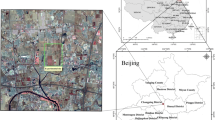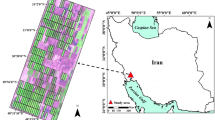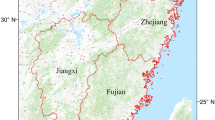Abstract
This study investigates the effects of different water stress levels on spectral information, leaf area index (LAI), and the performance of three machine learning (ML) algorithms in estimating crop water content (CWC) of sorghum. The results show that the spectral reflectance of sorghum varies with growth stage and irrigation treatment, but consistent patterns are observed for each treatment. The LAI of sorghum gradually increased throughout the growth stages, with the most significant variation observed during the flowering stage. In this study, three machine learning-based regression models, namely, extreme gradient boosting (XGBoost), random forest (RF), and support vector machine (SVM), were utilized to estimate sorghum CWC using hyperspectral measurements. Recursive feature elimination (RFE) method was used to select the optimal spectral reflectance wavelengths for the ML models, and principal component analysis (PCA) was used to reduce the dimensionality of the hyperspectral data. The results indicated that the RF model achieved the highest R2 (0.90) and lowest of RMSE (56.05) value using selected wavelengths, while the XGBoost model demonstrated superior accuracy and reliability in estimating CWC using dimensionality-reduced hyperspectral data (r = 0.96, RMSE = 45.77). Also, the study highlights the importance of vegetation index (VI) in CWC estimate. Some VIs, such as NDVI and MSAVI, performed poorly, while others, such as CL_Rededge and EVI, performed better. The study provides valuable insights into the effects of water stress levels on spectral information, LAI, and the performance of ML algorithms in estimating the CWC of sorghum. The findings have significant implications for precision agriculture, as accurate and reliable estimates of CWC can help farmers optimize irrigation and fertilizer applications, leading to improved crop yields and resource efficiency.








Similar content being viewed by others
Data availability
The data that support the findings of this study are available from the corresponding author upon reasonable request.
References
Allamine, H. M., Buyuktas, D., Karaca, C., Aydinsakir, K., & Erdurmus, C. (2023). Effect of regulated deficit irrigation on productivity, evapotranspiration and quality of grain sorghum. Irrigation Science, 1–17. https://doi.org/10.1007/s00271-022-00844-5
Arslan, H., Tasan, M., Yildirim, D., Koksal, E. S., & Cemek, B. (2014). Predicting field capacity, wilting point, and the other physical properties of soils using hyperspectral reflectance spectroscopy: Two different statistical approaches. Environmental Monitoring and Assessment, 186, 5077–5088. https://doi.org/10.1007/s10661-014-3761-2
Aydinsakir, K., Buyuktas, D., Dinç, N., Erdurmus, C., Bayram, E., & Yegin, A. B. (2021). Yield and bioethanol productivity of sorghum under surface and subsurface drip irrigation. Agricultural Water Management, 243, 106452. https://doi.org/10.1016/j.agwat.2020.106452
Beltrán, N. H., Duarte-Mermoud, M., Salah, S., Bustos, M., Peña-Neira, A. I., Loyola, E., & Jalocha, J. (2005). Feature selection algorithms using Chilean wine chromatograms as examples. Journal of Food Engineering, 67, 483–490. https://doi.org/10.1016/j.jfoodeng.2004.05.015
Bendorf, J., Heaton, E., Hartman, T., Aslan-Sungur, G., & VanLoocke, A. (2022). Agroecosystem model simulations reveal spatial variability in relative productivity in biomass sorghum and maize in Iowa, USA. GCB Bioenergy, 14, 1336–1360. https://doi.org/10.1111/gcbb.13004
Buschmann, C., & Nagel, E. (1993). In vivo spectroscopy and internal optics of leaves as basis for remote sensing of vegetation. International Journal of Remote Sensing, 14, 711–722. https://doi.org/10.1080/01431169308904370
Cemek, B., Arslan, H., Küçüktopcu, E., & Simsek, H. (2022). Comparative analysis of machine learning techniques for estimating groundwater deuterium and oxygen-18 isotopes. Stochastic Environmental Research and Risk Assessment, 36, 4271–4285. https://doi.org/10.1007/s00477-022-02262-7
Chen, T., & Guestrin, C. (2016). Xgboost: A scalable tree boosting system. In, Proceedings of the 22nd acm sigkdd international conference on knowledge discovery and data mining (pp. 785–794)
Chivasa, W., Mutanga, O., & Biradar, C. (2020). UAV-based multispectral phenotyping for disease resistance to accelerate crop improvement under changing climate conditions. Remote Sensing, 12, 2445. https://doi.org/10.3390/rs12152445
Clevers, J. G., Kooistra, L., & Schaepman, M. E. (2010). Estimating canopy water content using hyperspectral remote sensing data. International Journal of Applied Earth Observation and Geoinformation, 12, 119–125. https://doi.org/10.1016/j.jag.2010.01.007
Colombo, R., Meroni, M., Marchesi, A., Busetto, L., Rossini, M., Giardino, C., & Panigada, C. (2008). Estimation of leaf and canopy water content in poplar plantations by means of hyperspectral indices and inverse modeling. Remote Sensing of Environment, 112, 1820–1834. https://doi.org/10.1016/j.rse.2007.09.005
Das, B., Sahoo, R. N., Pargal, S., Krishna, G., Verma, R., Viswanathan, C., Sehgal, V. K., & Gupta, V. K. (2021). Evaluation of different water absorption bands, indices and multivariate models for water-deficit stress monitoring in rice using visible-near infrared spectroscopy. Spectrochimica Acta Part A: Molecular and Biomolecular Spectroscopy, 247, 119104. https://doi.org/10.1016/j.saa.2020.119104
El-Hendawy, S. E., Al-Suhaibani, N. A., Hassan, W. M., Dewir, Y. H., Elsayed, S., Al-Ashkar, I., Abdella, K. A., & Schmidhalter, U. (2019). Evaluation of wavelengths and spectral reflectance indices for high-throughput assessment of growth, water relations and ion contents of wheat irrigated with saline water. Agricultural Water Management, 212, 358–377. https://doi.org/10.1016/j.agwat.2018.09.009
Elsherbiny, O., Fan, Y., Zhou, L., & Qiu, Z. (2021). Fusion of feature selection methods and regression algorithms for predicting the canopy water content of rice based on hyperspectral data. Agriculture, 11, 51.
Eshkabilov, S., Stenger, J., Knutson, E. N., Küçüktopcu, E., Simsek, H., & Lee, C. W. (2022). Hyperspectral image data and waveband indexing methods to estimate nutrient concentration on lettuce (Lactuca sativa L.) cultivars. Sensors, 22, 8158. https://doi.org/10.3390/s22218158
Friedman, J. H. (2002). Stochastic gradient boosting. Computational Statistics & Data Analysis, 38, 367–378. https://doi.org/10.1016/S0167-9473(01)00065-2
Gamon, J., Penuelas, J., & Field, C. (1992). A narrow-waveband spectral index that tracks diurnal changes in photosynthetic efficiency. Remote Sensing of Environment, 41, 35–44. https://doi.org/10.1016/0034-4257(92)90059-S
Gao, R., Torres-Rua, A., Nassar, A., Alfieri, J., Aboutalebi, M., Hipps, L., Ortiz, N. B., McElrone, A. J., Coopmans, C., & Kustas, W. (2021). Evapotranspiration partitioning assessment using a machine-learning-based leaf area index and the two-source energy balance model with sUAV information. In, Autonomous Air and Ground Sensing Systems for Agricultural Optimization and Phenotyping VI (pp. 106–129): SPIE
Gao, R., Torres-Rua, A. F., Aboutalebi, M., White, W. A., Anderson, M., Kustas, W. P., Agam, N., Alsina, M. M., Alfieri, J., & Hipps, L. (2022). LAI estimation across California vineyards using sUAS multi-seasonal multi-spectral, thermal, and elevation information and machine learning. Irrigation Science, 40, 731–759. https://doi.org/10.1007/s00271-022-00776-0
Gitelson, A. A., Gritz, Y., & Merzlyak, M. N. (2003). Relationships between leaf chlorophyll content and spectral reflectance and algorithms for non-destructive chlorophyll assessment in higher plant leaves. Journal of Plant Physiology, 160, 271–282.
Gitelson, A. A., Kaufman, Y. J., Stark, R., & Rundquist, D. (2002). Novel algorithms for remote estimation of vegetation fraction. Remote Sensing of Environment, 80, 76–87. https://doi.org/10.1016/S0034-4257(01)00289-9
Gómez-Candón, D., Bellvert, J., & Royo, C. (2021). Performance of the two-source energy balance (TSEB) model as a tool for monitoring the response of durum wheat to drought by high-throughput field phenotyping. Frontiers in plant science, 12, 658357. https://doi.org/10.3389/fpls.2021.658357
Granitto, P. M., Furlanello, C., Biasioli, F., & Gasperi, F. (2006). Recursive feature elimination with random forest for PTR-MS analysis of agroindustrial products. Chemometrics and Intelligent Laboratory Systems, 83, 83–90. https://doi.org/10.1016/j.chemolab.2006.01.007
Guan, Y., Grote, K., Schott, J., & Leverett, K. (2022). Prediction of soil water content and electrical conductivity using random forest methods with UAV multispectral and ground-coupled geophysical data. Remote Sensing, 14, 1023. https://doi.org/10.3390/rs14041023
Guo, Q., Li, J., Zhou, F., Li, G., & Lin, J. (2023). An open-set fault diagnosis framework for MMCs based on optimized temporal convolutional network. Applied Soft Computing, 133, 109959. https://doi.org/10.1016/j.asoc.2022.109959
Guyon, I., & Elisseeff, A. (2003). An introduction to variable and feature selection. Journal of Machine Learning Research, 3, 1157–1182.
Haboudane, D., Miller, J. R., Pattey, E., Zarco-Tejada, P. J., & Strachan, I. B. (2004). Hyperspectral vegetation indices and novel algorithms for predicting green LAI of crop canopies: Modeling and validation in the context of precision agriculture. Remote Sensing of Environment, 90, 337–352. https://doi.org/10.1016/j.rse.2003.12.013
Hasanlou, M., & Samadzadegan, F. (2012). Comparative study of intrinsic dimensionality estimation and dimension reduction techniques on hyperspectral images using K-NN classifier. IEEE Geoscience and Remote Sensing Letters, 9, 1046–1050. https://doi.org/10.1109/LGRS.2012.2189547
Hoi, S. C., Jin, R., Zhu, J., & Lyu, M. R. (2009). Semisupervised svm batch mode active learning with applications to image retrieval. ACM Transactions on Information Systems (TOIS), 27, 1–29. https://doi.org/10.1145/1508850.1508854
Hotelling, H. (1933). Analysis of a complex of statistical variables into principal components. Journal of Educational Psychology, 24, 417. https://doi.org/10.1037/h0071325
Ilniyaz, O., Kurban, A., & Du, Q. (2022). Leaf area index estimation of pergola-trained vineyards in arid regions based on UAV RGB and multispectral data using machine learning methods. Remote Sensing, 14, 415. https://doi.org/10.3390/rs14020415
Irik, H. A., & Kirnak, H. (2022). Evaluation of spectral vegetation indices for drip irrigated pumpkin seed under semi-arid conditions. Arabian Journal of Geosciences, 15, 861.
Ji, H.-Y., Wang, X.-Z., He, Y.-L., & Li, W.-L. (2014). A study on relationships between heuristics and optimal cuts in decision tree induction. Computers & Electrical Engineering, 40, 1429–1438. https://doi.org/10.1016/j.compeleceng.2013.11.030
Jin, X., Shi, C., Yu, C. Y., Yamada, T., & Sacks, E. J. (2017). Determination of leaf water content by visible and near-infrared spectrometry and multivariate calibration in Miscanthus. Frontiers in Plant Science, 8, 721. https://doi.org/10.3389/fpls.2017.00721
Jordan, C. F. (1969). Derivation of leaf-area index from quality of light on the forest floor. Ecology, 50, 663–666. https://doi.org/10.2307/1936256
Kilincer, I. F., Ertam, F., Sengur, A., Tan, R.-S., & Acharya, U. R. (2023). Automated detection of cybersecurity attacks in healthcare systems with recursive feature elimination and multilayer perceptron optimization. Biocybernetics and Biomedical Engineering, 43, 30–41. https://doi.org/10.1016/j.bbe.2022.11.005
Köksal, E. S. (2011). Hyperspectral reflectance data processing through cluster and principal component analysis for estimating irrigation and yield related indicators. Agricultural Water Management, 98, 1317–1328. https://doi.org/10.1016/j.agwat.2011.03.014
Küçüktopcu, E. (2023). Comparative analysis of data-driven techniques to predict heating and cooling energy requirements of poultry buildings. Buildings, 13, 142. https://doi.org/10.3390/buildings13010142
Li, Y.-f., Xu, Z.-h., Hao, Z.-b., Yao, X., Zhang, Q., Huang, X.-y., Li, B., He, A.-q., Li, Z.-l., & Guo, X.-y. (2023). A comparative study of the performances of joint RFE with machine learning algorithms for extracting Moso bamboo (Phyllostachys pubescens) forest based on UAV hyperspectral images. Geocarto International, 1–21. https://doi.org/10.1080/10106049.2023.2207550
Lichtenthaler, H. K., Lang, M., Sowinska, M., Heisel, F., & Miehe, J. (1996). Detection of vegetation stress via a new high resolution fluorescence imaging system. Journal of Plant Physiology, 148, 599–612. https://doi.org/10.1016/S0176-1617(96)80081-2
Ma, Y., Zhang, Q., Yi, X., Ma, L., Zhang, L., Huang, C., Zhang, Z., & Lv, X. (2022). Estimation of cotton leaf area index (LAI) based on spectral transformation and vegetation index. Remote Sensing, 14, 136. https://doi.org/10.3390/rs14010136
Meier, M., Kittle, J. D., & Yee, X. C. (2022). Supervised dimension reduction for optical vapor sensing. RSC Advances, 12, 9579–9586. https://doi.org/10.1039/D1RA08774F
Meiyan, S., Qizhou, D., ShuaiPeng, F., Xiaohong, Y., Jinyu, Z., Lei, M., Baoguo, L., & Yuntao, M. (2022). Improved estimation of canopy water status in maize using UAV-based digital and hyperspectral images. Computers and Electronics in Agriculture, 197, 106982. https://doi.org/10.1016/j.compag.2022.106982
Ndlovu, H. S., Odindi, J., Sibanda, M., Mutanga, O., Clulow, A., Chimonyo, V. G., & Mabhaudhi, T. (2021). A comparative estimation of maize leaf water content using machine learning techniques and unmanned aerial vehicle (UAV)-based proximal and remotely sensed data. Remote Sensing, 13, 4091. https://doi.org/10.3390/rs13204091
Olson, S. N., Ritter, K., Rooney, W., Kemanian, A., McCarl, B. A., Zhang, Y., Hall, S., Packer, D., & Mullet, J. (2012). High biomass yield energy sorghum: Developing a genetic model for C4 grass bioenergy crops. Biofuels, Bioproducts and Biorefining, 6, 640–655. https://doi.org/10.1002/bbb.1357
Pearson, K. (1901). LIII. On lines and planes of closest fit to systems of points in space. The London, Edinburgh, and Dublin Philosophical Magazine and Journal of Science, 2, 559–572. https://doi.org/10.1080/14786440109462720
Perry, C. R., Jr., & Lautenschlager, L. F. (1984). Functional equivalence of spectral vegetation indices. Remote Sensing of Environment, 14, 169–182. https://doi.org/10.1016/0034-4257(84)90013-0
Qiao, L., Zhao, R., Tang, W., An, L., Sun, H., Li, M., Wang, N., Liu, Y., & Liu, G. (2022). Estimating maize LAI by exploring deep features of vegetation index map from UAV multispectral images. Field Crops Research, 289, 108739. https://doi.org/10.1016/j.fcr.2022.108739
Ren, S., Guo, B., Wang, Z., Wang, J., Fang, Q., & Wang, J. (2022). Optimized spectral index models for accurately retrieving soil moisture (SM) of winter wheat under water stress. Agricultural Water Management, 261, 107333, https://doi.org/10.1016/j.agwat.2021.107333
Salata, S., Ozkavaf-Senalp, S., Velibeyoğlu, K., & Elburz, Z. (2022). Land suitability analysis for vineyard cultivation in the izmir metropolitan area. Land, 11, 416.
Samat, A., Li, E., Wang, W., Liu, S., Lin, C., & Abuduwaili, J. (2020). Meta-XGBoost for hyperspectral image classification using extended MSER-guided morphological profiles. Remote Sensing, 12, 1973. https://doi.org/10.3390/rs12121973
Shi, B., Yuan, Y., Zhuang, T., Xu, X., Schmidhalter, U., Ata-UI-Karim, S.T., Zhao, B., Liu, X., Tian, Y., & Zhu, Y. (2022). Improving water status prediction of winter wheat using multi-source data with machine learning. European Journal of Agronomy, 139, 126548. https://doi.org/10.1016/j.eja.2022.126548
Sibanda, M., Onisimo, M., Dube, T., & Mabhaudhi, T. (2021). Quantitative assessment of grassland foliar moisture parameters as an inference on rangeland condition in the mesic rangelands of southern Africa. International Journal of Remote Sensing, 42, 1474–1491. https://doi.org/10.1080/01431161.2020.1832282
Sims, D. A., & Gamon, J. A. (2003). Estimation of vegetation water content and photosynthetic tissue area from spectral reflectance: A comparison of indices based on liquid water and chlorophyll absorption features. Remote Sensing of Environment, 84, 526–537. https://doi.org/10.1016/S0034-4257(02)00151-7
Smith, R., Adams, J., Stephens, D., & Hick, P. (1995). Forecasting wheat yield in a Mediterranean-type environment from the NOAA satellite. Australian Journal of Agricultural Research, 46, 113–125.
Tunca, E., Köksal, E. S., Torres-Rua, A., Kustas, W. P., & Nieto, H. (2022). Estimation of bell pepper evapotranspiration using two-source energy balance model based on high-resolution thermal and visible imagery from unmanned aerial vehicles. Journal of Applied Remote Sensing, 16, 022204–022204. https://doi.org/10.1117/1.JRS.16.022204
Wang, X., Zhao, C., Guo, N., Li, Y., Jian, S., & Yu, K. (2015). Determining the canopy water stress for spring wheat using canopy hyperspectral reflectance data in loess plateau semiarid regions. Spectroscopy Letters, 48, 492–498. https://doi.org/10.1080/00387010.2014.909495
Wanga, M. A., Shimelis, H., & Mengistu, G. (2022). Sorghum production in northern namibia: Farmers’ perceived constraints and trait preferences. Sustainability, 14, 10266. https://doi.org/10.3390/su141610266
White, D., Williams, M., & Barr, S. (2008). Detecting sub-surface soil disturbance using hyperspectral first derivative band rations of associated vegetation stress. Int. Arch. Photogramm. Remote Sens. Spat. Inf. Sci, 27, 243–248.
Winder, S., Hua, G., & Brown, M. (2009). Picking the best daisy. In, 2009 IEEE conference on computer vision and pattern recognition (pp. 178–185): IEEE
Xu, X., Lu, J., Zhang, N., Yang, T., He, J., Yao, X., Cheng, T., Zhu, Y., Cao, W., & Tian, Y. (2019). Inversion of rice canopy chlorophyll content and leaf area index based on coupling of radiative transfer and Bayesian network models. ISPRS Journal of Photogrammetry and Remote Sensing, 150, 185–196. https://doi.org/10.1016/j.isprsjprs.2019.02.013
Yamaguchi, T., Tanaka, Y., Imachi, Y., Yamashita, M., & Katsura, K. (2020). Feasibility of combining deep learning and RGB images obtained by unmanned aerial vehicle for leaf area index estimation in rice. Remote Sensing, 13, 84. https://doi.org/10.3390/rs13010084
Yildirim, D., Küçüktopcu, E., Cemek, B., & Simsek, H. (2023). Comparison of machine learning techniques and spatial distribution of daily reference evapotranspiration in Türkiye. Applied Water Science, 13, 107. https://doi.org/10.1007/s13201-023-01912-7
Yue, J., Feng, H., Jin, X., Yuan, H., Li, Z., Zhou, C., Yang, G., & Tian, Q. (2018). A comparison of crop parameters estimation using images from UAV-mounted snapshot hyperspectral sensor and high-definition digital camera. Remote Sensing, 10, 1138. https://doi.org/10.3390/rs10071138
Zhang, J., Zhang, W., Xiong, S., Song, Z., Tian, W., Shi, L., & Ma, X. (2021). Comparison of new hyperspectral index and machine learning models for prediction of winter wheat leaf water content. Plant Methods, 17, 1–14. https://doi.org/10.1186/s13007-021-00737-2
Zhang, X., Zhang, K., Wu, S., Shi, H., Sun, Y., Zhao, Y., Fu, E., Chen, S., Bian, C., & Ban, W. (2022). An investigation of winter wheat leaf area index fitting model using spectral and canopy height model data from unmanned aerial vehicle imagery. Remote Sensing, 14, 5087. https://doi.org/10.3390/rs14205087
Zhao, J., Li, H., Chen, C., Pang, Y., & Zhu, X. (2022). Detection of water content in lettuce canopies based on hyperspectral imaging technology under outdoor conditions. Agriculture, 12, 1796. https://doi.org/10.3390/agriculture12111796
Zhou, X., Yang, W., Luo, K., & Tang, X. (2022). Estimation of aboveground vegetation water storage in natural forests in jiuzhaigou national nature reserve of China using machine learning and the combination of landsat 8 and sentinel-2 data. Forests, 13, 507. https://doi.org/10.3390/f13040507
Zhu, L., Chen, Z., Wang, J., Ding, J., Yu, Y., Li, J., Xiao, N., Jiang, L., Zheng, Y., & Rimmington, G. M. (2014). Monitoring plant response to phenanthrene using the red edge of canopy hyperspectral reflectance. Marine pollution bulletin, 86, 332–341. https://doi.org/10.1016/j.marpolbul.2014.06.046
Funding
This study was supported by The Scientific and Technological Research Council of Turkey (118O831).
Author information
Authors and Affiliations
Contributions
Emre Tunca, designed the study, data collection, analyzed the data, and wrote the manuscript. Eyüp Selim Köksal, conceived the research project, participated in the data collection and analysis, and provided critical feedback on the manuscript. Elif Öztürk, contributed to the data collection. Hasan Akay and Sakine Çetin Taner assisted in the interpretation of the results. All authors reviewed and approved the final version of the manuscript.
Corresponding author
Ethics declarations
Conflict of interest
The authors declare no competing interests.
Additional information
Publisher's Note
Springer Nature remains neutral with regard to jurisdictional claims in published maps and institutional affiliations.
Rights and permissions
Springer Nature or its licensor (e.g. a society or other partner) holds exclusive rights to this article under a publishing agreement with the author(s) or other rightsholder(s); author self-archiving of the accepted manuscript version of this article is solely governed by the terms of such publishing agreement and applicable law.
About this article
Cite this article
Tunca, E., Köksal, E.S., Öztürk, E. et al. Accurate estimation of sorghum crop water content under different water stress levels using machine learning and hyperspectral data. Environ Monit Assess 195, 877 (2023). https://doi.org/10.1007/s10661-023-11536-8
Received:
Accepted:
Published:
DOI: https://doi.org/10.1007/s10661-023-11536-8




